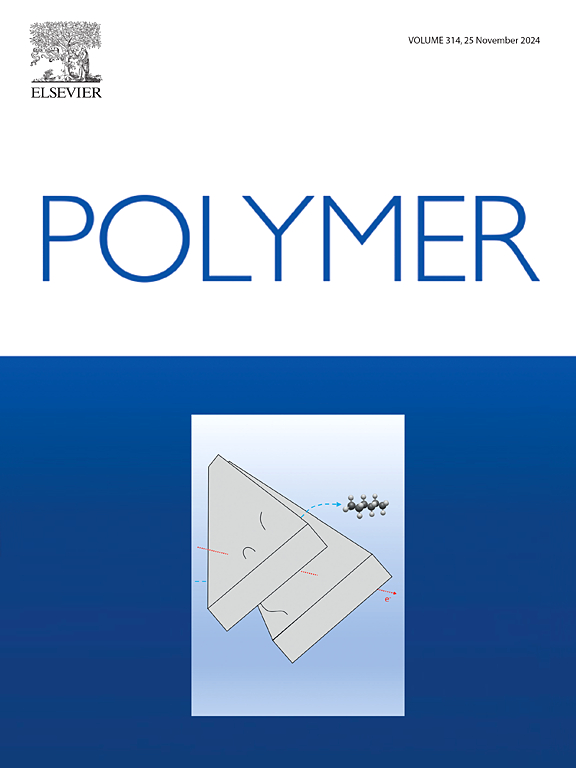Enhancing inter-bead bonding of PEBA bead foams by boosting interfacial diffusion during in-mold foaming and molding
IF 4.1
2区 化学
Q2 POLYMER SCIENCE
引用次数: 0
Abstract
Polyether block amide (PEBA) foams have attracted considerable attention in advanced footwear technology, owing to their low density and exceptional resilience. However, existing research predominantly focuses on block-type PEBA foams, with relatively limited investigation into bead foam molding techniques. Herein, we introduce an in-mold foaming and molding (IMFM) strategy, where low-melting-point ethylene-vinyl acetate (EVA) was blended with PEBA to overcome the challenge of poor inter-bead bonding in pure PEBA bead foam parts. The molten EVA acts as an effective interfacial adhesive during the IMFM process. This is demonstrated by a fundamental shift in the fracture mode: from inter-bead failure in pure PEBA parts to intra-bead fracture in the PEBA/EVA blends. Consequently, the optimal formulation with 5 wt% EVA achieved a low density of 0.107 g/cm3 and a high rebound resilience of 73.8 %, coupled with a 15 % increase in tensile strength (to 0.63 ± 0.04 MPa) and an 84 % increase in elongation at break (to 137 ± 6.6 %). Furthermore, the confined nature of the IMFM process generates sufficient internal pressure to stabilize the cellular structure, preventing cell collapse. This straightforward strategy offers a scalable and feasible approach for the mass production of high-performance PEBA bead foam products.


通过在模内发泡和成型过程中促进界面扩散来增强PEBA泡沫珠间粘合
聚醚块酰胺(PEBA)泡沫由于其低密度和卓越的弹性,在先进的鞋类技术中引起了相当大的关注。然而,现有的研究主要集中在块状PEBA泡沫材料上,对珠状泡沫成型技术的研究相对有限。在此,我们介绍了一种模内发泡和成型(IMFM)策略,其中低熔点的乙烯-醋酸乙烯(EVA)与PEBA混合,以克服纯PEBA珠状泡沫部件的珠间粘合不良的挑战。熔融EVA在IMFM过程中充当有效的界面粘合剂。断裂模式的根本转变证明了这一点:从纯PEBA零件的头间断裂到PEBA/EVA共混物的头内断裂。因此,含5 wt% EVA的最佳配方实现了0.107 g/cm3的低密度和73.8%的高回弹弹性,同时抗拉强度增加15%(达到0.63±0.04 MPa),断裂伸长率增加84%(达到137±6.6%)。此外,IMFM过程的局限性产生了足够的内部压力来稳定细胞结构,防止细胞崩溃。这种直接的策略为大规模生产高性能PEBA泡沫产品提供了一种可扩展和可行的方法。
本文章由计算机程序翻译,如有差异,请以英文原文为准。
求助全文
约1分钟内获得全文
求助全文
来源期刊

Polymer
化学-高分子科学
CiteScore
7.90
自引率
8.70%
发文量
959
审稿时长
32 days
期刊介绍:
Polymer is an interdisciplinary journal dedicated to publishing innovative and significant advances in Polymer Physics, Chemistry and Technology. We welcome submissions on polymer hybrids, nanocomposites, characterisation and self-assembly. Polymer also publishes work on the technological application of polymers in energy and optoelectronics.
The main scope is covered but not limited to the following core areas:
Polymer Materials
Nanocomposites and hybrid nanomaterials
Polymer blends, films, fibres, networks and porous materials
Physical Characterization
Characterisation, modelling and simulation* of molecular and materials properties in bulk, solution, and thin films
Polymer Engineering
Advanced multiscale processing methods
Polymer Synthesis, Modification and Self-assembly
Including designer polymer architectures, mechanisms and kinetics, and supramolecular polymerization
Technological Applications
Polymers for energy generation and storage
Polymer membranes for separation technology
Polymers for opto- and microelectronics.
 求助内容:
求助内容: 应助结果提醒方式:
应助结果提醒方式:


